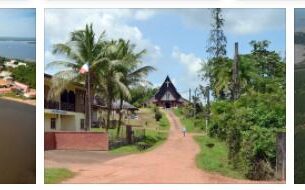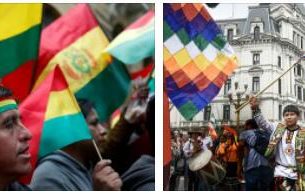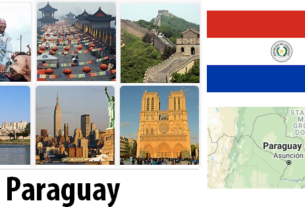TERRITORY: HUMAN GEOGRAPHY
Most of the Bolivian population descends directly from the ancient inhabitants of the plateau, in particular the Aymará (concentrated around Lake Titicaca) and the Quechua ; in the eastern lowlands the Amerindians are represented by scattered groups of Amazonian and Chaco gatherers and hunters, among which Guaraní people have also crept. Overall, the Amerindians make up 53% of the population: 29% are Quechua and the Aymará the remaining 24%. The high percentage of Indians is due to the harsh environmental conditions, which have always limited the settlement of whites (15%), mostly of Spanish origin, while there was no immigration of Italians and other Europeans, as is occurred in Brazil and Argentina (in the Eastinstead, numerous Japanese settlers have settled); more relevant is the percentage of mestizos (30%). %). The demographic boom occurred in Bolivia, a country located in South America according to politicsezine, starting from the second half of the twentieth century: at the 1900 census the inhabitants were about 1,600,000, a figure considered to be inadequate, and just over 2,000,000 in 1950 compared to over 8,000,000 surveyed in 2001. The annual growth is high (1.9% in the period 2000-2008) also considering the high values of infant mortality (especially among children under 1 year old), caused by respiratory infections and diarrhea especially in rural areas inhabited by indigenous people, where many children suffer the consequences of malnutrition. Life expectancy is the lowest on the continent, limited to 63 years for men and 68 for women, and the age pyramid is squeezed down: almost 40% of Bolivians are under the age of 14 and it is estimated that over 2 million children live below the poverty line and over half a million of them are forced to work. Over the years, outbound migratory flows have been contained and limited to other South American countries: many Bolivians have emigrated to Brazil and Argentina, often working there without regular permits. The density of the population is naturally very low (9 residents/km²), even if it registered a certain increase in the last years of the 20th century. Almost half of Bolivians are concentrated in the departments of Over the years, outbound migratory flows have been contained and limited to other South American countries: many Bolivians have emigrated to Brazil and Argentina, often working there without regular permits. The density of the population is naturally very low (9 residents/km²), even if it registered a certain increase in the last years of the 20th century. Almost half of Bolivians are concentrated in the departments of Over the years, outbound migratory flows have been contained and limited to other South American countries: many Bolivians have emigrated to Brazil and Argentina, often working there without regular permits. The density of the population is naturally very low (9 residents/km²), even if it registered a certain increase in the last years of the 20th century. Almost half of Bolivians are concentrated in the departments ofLa Paz and Cochabamba which occupy less than 20% of the territory, with average densities, however, not high (21 inhabitants / km² the first and 33 inhabitants / km² the second); sparsely populated are the north-eastern areas corresponding to the Beni and Pando departments, where the density is around 1-2 residents/km². In the early 2000s, the route of the road linking Santa Cruz de la Sierra to Cochabamba (500 km) was renewed: it runs along gently sloping river furrows, crossing an area previously isolated, covered by tropical vegetation and extensive coca plantations. This latter activity represents a real social scourge for the East, which the new artery could help heal, favoring the replacement with other crops, whose products would find an easy way to market both towards the Bolivian plateau and towards Brazil. At present it is estimated that most Bolivians live between 2500 and 4000 m; the upper limit of the settlement is just below 4300 m; they are poor villages of peasants who cultivate small patches of land next to adobe and thatched-roof houses, or, in the arid puna, are dedicated to sheep farming. Around Lake Titicaca and in the valleys there are centers that also have commercial functions, especially those located along the railways that cross the plateau; particularly dense is the yungas, with large settlements along the valley roads. In the last decades of the twentieth century, the migratory flow towards cities has increased considerably: this is demonstrated by the fact that, in urban areas, the demographic dynamics are, on the one hand, more intense, with a higher birth rate than in rural areas, on the other, it suffers from a higher mortality rate, as a sign not so much of structural aging as of precarious social and hygienic conditions. In 2008, the urban population represented 66.1% of the national total. The most populous city is La Paz (over 1,500,000 in the urban agglomeration), whose development is due to its role as administrative capital, seat of government and rail links with Chile and Argentina. Sucre is the old capital (it is still legal capital), characteristic for its dignified colonial appearance. Mining and trading centers of the plateau arePotosí, the highest city in South America being located at 3976 m, Oruro and Cochabamba, the latter hub of communications between the plateau and the Orient, which instead has its maximum center in Santa Cruz de la Sierra (second city of the country, agricultural market and connection of the railway lines that unite Bolivia with Argentina and Brazil.
TERRITORY: ENVIRONMENT
The harshest conditions occur in the southern part of the plateau, where rainfall does not even reach 400 mm and where the higher altitude further lowers the thermal values: this is the environment of the puna, a desolate steppe of grasses, such as the Stipa ichu. Towards the north, as the altitude decreases, the puna is interrupted by oasis areas and fields planted with cereals and potatoes; finally in the highest areas of the cordillera there are the tierras heladas, affected by glacialism above 5000 m. The lowlands also have various aspects: the northernmost areas, sprinkled with abundant rainfall, are covered by the Amazonian rainforest; in the center-south, poorer in rains and subject to a climate with a prolonged dry season, the caatinga takes over, a sort of savannah widespread in all inland areas of South America, with deciduous trees and more or less xerophilous plants ; for large stretches, towards the Chaco, it presents itself with vast grassy areas (campos limpios). The fauna also differs according to the altitude and the characteristics of the environment: if the plateau essentially hosts Camelid mammals, such as the llama, the vicuna, and the alpaca, the eastern lowlands have a greater variety with birds, including condors, amphibians, reptiles, such as the alligator and turtle, and mammals such as anteater, tapir, jaguar, porcupine, capybara, bear from the glasses and the Mazama chunyi, a deer endemic to the forests between Peru and Bolivia that is considered an endangered species. The rich forest mantle, which covers 53.7% of the territory, is considered to be at high risk due to the continuous felling of trees to obtain valuable timber, a practice that accentuates the problem of soil erosion, which has been underway for some time due to the spread of inappropriate methods of cultivation (indigenous people are used to burning the plots of land to increase their fertility). In addition, the discharges of the mining industries continue to contaminate the waters, threatening the country’s water resources, while in the large cities in recent decades the increase in air pollution caused by exhaust gases has been felt. Parks and protected areas affect the 21st, 2% of the territory and are administered at departmental level by the National System of Protected Areas. In addition to the 13 national parks, located in all Bolivian regions, there are 9 other areas of national interest including various forest, wildlife and biosphere reserves. In 2000 the UNESCO has declared the Noel Kempff National Park a very large area (1,523,000 hectares) in the department of Beni on the border with Brazil in which different habitats coexist, from rainforest to swamps to savannah: an environment uncontaminated of great value also for the study of the evolution of living species.




